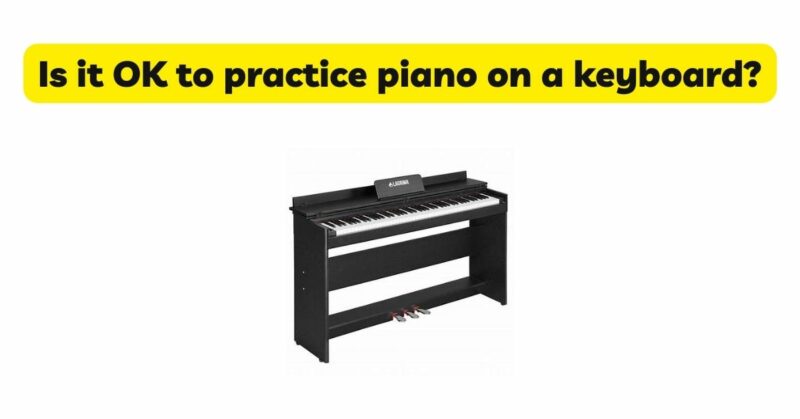Practicing the piano is a fundamental aspect of skill development and musical growth. For aspiring pianists, the question often arises whether it is acceptable to practice on a keyboard instead of an acoustic piano. In this article, we will delve into the considerations and benefits of practicing piano on a keyboard. By examining the advantages, addressing potential limitations, and understanding the role of keyboards in the learning process, we aim to provide insights that can guide pianists in making an informed decision about their practice instrument.
- Accessibility and Convenience: One of the primary advantages of practicing piano on a keyboard is the accessibility and convenience it offers. Keyboards are typically lightweight, compact, and portable, allowing for easy transportation and setup. Unlike acoustic pianos, which require a dedicated space and professional assistance for relocation, keyboards can be easily moved and stored, making them suitable for learners who have limited space or need to practice in different locations. This accessibility and convenience contribute to regular practice, ensuring that learners can consistently engage with their instrument.
- Affordability: Financial considerations often play a significant role in the decision-making process. Acoustic pianos, especially high-quality ones, can be expensive and require maintenance, tuning, and potential refurbishments over time. In contrast, keyboards are generally more affordable, making them a viable option for beginners or those on a limited budget. Entry-level keyboards provide a range of features and functionalities at a fraction of the cost of an acoustic piano, allowing aspiring pianists to start their musical journey without a significant upfront investment.
- Technological Advancements: Keyboards have evolved significantly over the years, incorporating technological advancements that enhance the practice experience. Many keyboards now offer features such as weighted keys, graded hammer action, and touch sensitivity, aiming to replicate the touch and feel of an acoustic piano. These advancements help learners develop finger strength, control, and proper technique. Additionally, keyboards often come equipped with built-in metronomes, recording capabilities, and educational modes that provide valuable tools for effective practice and skill development.
- Sound Reproduction: While keyboards may not fully replicate the sound of an acoustic piano, modern digital keyboards have made remarkable progress in sound sampling technology. They aim to recreate the sound and tonal characteristics of an acoustic piano as faithfully as possible. High-quality keyboards often provide sampled piano sounds that can satisfy the needs of learners at various skill levels. While the sound may not have the same depth and complexity as an acoustic piano, it can still offer a satisfying playing experience and aid in developing musical expression and dynamics.
- Learning Tools and Resources: Keyboards offer an abundance of learning tools and resources that can enhance the practice experience. Many keyboards include built-in tutorials, interactive lessons, and practice modes designed specifically for beginners. These features provide step-by-step guidance, finger placement assistance, and real-time feedback, allowing learners to progress at their own pace. Additionally, keyboards can be connected to computers or mobile devices, opening up a world of online tutorials, sheet music libraries, and interactive learning platforms. These resources expand the possibilities for practice and offer valuable support for skill development.
- Technique Development: Developing proper technique is a crucial aspect of piano playing, regardless of the instrument used. While acoustic pianos provide a touch-sensitive playing experience that directly influences sound production, keyboards with weighted keys and graded hammer action can approximate the touch sensitivity of an acoustic piano. With focused practice and attention to detail, learners can develop and refine their technique on a keyboard. It is important to note that while keyboards can provide a solid foundation for technique, transitioning to an acoustic piano may require adjustments to accommodate the nuances of touch and sound production.
- Transitioning to Acoustic Pianos: A common concern among pianists practicing on keyboards is the ability to transition effectively to playing on acoustic pianos. Acoustic pianos have unique touch sensitivity and tonal qualities that may require some adjustment when switching from a keyboard. However, with guidance from an experienced teacher and focused practice on acoustic pianos when possible, learners can adapt their skills to different pianos. The core skills developed, such as note reading, hand coordination, and music theory, can be transferred between instruments, allowing for a smooth transition.
Conclusion: Practicing piano on a keyboard offers numerous advantages and can be a suitable choice for learners at various levels. The accessibility, affordability, and technological advancements of keyboards provide a platform for consistent practice and skill development. While keyboards may not fully replicate the touch, sound, and authenticity of an acoustic piano, they offer valuable learning tools, convenience, and sound reproduction that contribute to effective practice. Ultimately, the choice between practicing on a keyboard or an acoustic piano should be based on individual circumstances, preferences, and goals. What matters most is the dedication, passion, and commitment to regular practice, regardless of the instrument chosen.


